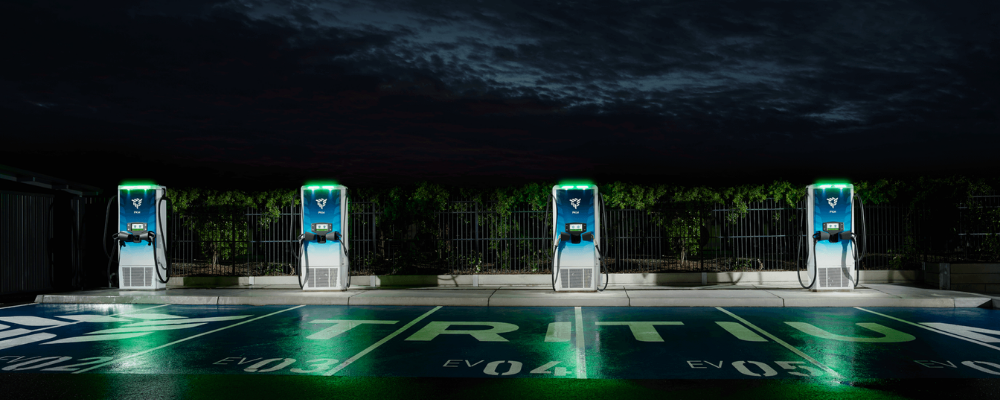Level 1, 2, and 3 Charging

Not all EV chargers are equal. Like EVs, they come in many different configurations and offer different features. Whether you’re shopping for a personal electric vehicle or you’re thinking about electrifying your fleet, sorting it all out can be a chore. Here we’ll briefly explain the different types of chargers, how they work, and what it all means for people who use their EVs for at home or for business.
Levels
To make sense of EV chargers, the EV industry created three “levels” of charging that roughly correlate to charging power and speed—level 1 being the lowest power/slowest speed. This gives us a straightforward way to categorize and organize EV chargers.
Level 1 Charging
Level 1 charging is the slowest and most accessible form of charging. It uses the standard home wall outlet (120v in US, 220v in EU) and your EV’s onboard charging hardware to charge your EV’s batteries. Level 1 charging usually delivers around 3-5 miles (5-8 km) of range per hour of charging. Not great, but if you leave your EV plugged in overnight you’ll probably have enough power to get to work in the morning. On the other hand, if you’re going on a road trip, it could take more than 30 hours to get 105 miles (169 km) of range. Level 1 charging is slow, but it’s cheap—the equipment comes with your EV and all you really need is an extension cord. If you have a short commute or work from home, you may not need more than level 1 charging.
But if you have a longer commute, or if you can’t wait a few days to fully charge your EV, you’ll need something faster. And if you’re running a fleet, level 1 charging won’t delivery anywhere near the power you need.
Level 2 Charging
Level 2 is the fastest way to charge your vehicle at home. It uses the 240v power lines in your home that are dedicated to high-power appliances like clothes dryers, electric ovens, or central air conditioners. These higher-voltage lines provide more current (amperage) than a standard wall outlet, which means you can charge your EV faster. A level 2 charger can fully charge most passenger EVs in 8-10 hours, which is about three times as fast as a level 1 charger.
Depending on your home, you may need to have an electrician install a second 240-volt power outlet with its own circuit breaker to use a level 2 charger. Some chargers need to be hard wired into your home’s electrical system by a certified electrician and may also require a separate circuit breaker. Many can be used without a dedicated circuit breaker at lower charging levels. It’s also possible to use your existing clothes dryer outlet, swapping out the dryer’s plug for your charger’s when you need to. But before you use any level 2 charger, it’s a good idea to have an electrician inspect your home’s electrical system to make sure it can handle the power draw. High-power chargers and appliances can overload your home’s wiring, causing blown circuit breakers or even fires.
Level 2 charging may work great at home, but it won’t deliver enough power for businesses or fleets. They require more power to charge batteries much faster.
Level 3 Charging
Level 3 charging doesn’t really exist as a category—it’s just a convenient way to categorize everything faster than level 2 charging. When a company or publication mentions level 3 charging, they mean DC fast charging.
DC Fast Charging
Direct current (DC) fast charging is the fastest way to charge up your EV. Lithium-ion batteries store and release DC power, and there’s no way to charge them without first transforming the alternating current (AC) power in the electrical grid to DC power. Level 2 home chargers can only handle so much power. Commercial DC fast chargers connect directly to high-voltage AC power lines and have dedicated infrastructure for transforming it into DC power. Because of this, they can deliver much more power than level 2 home chargers. DC fast chargers can typically charge an EV from 20 to 80 percent in as little as 15 minutes. They are perfect for highways, retail environments, delivery vehicles, and even electrical industrial equipment.
DC fast chargers like our PKM150 are a quick and convenient way for EV drivers to charge up while they’re shopping, taking a road trip, or even grabbing a bite to eat. They will also be essential to “last-mile” delivery EVs that deliver goods from local warehouses to homes and businesses. Walmart and Amazon have both purchased electric delivery vehicles for last-mile delivery and they plan to purchase more in the coming years.
For a deeper dive into how DC fast chargers work, read our article here.
Expect to see more DC fast chargers at shopping centers, restaurants, rest stops, gas stations, and even convenience stores. Unlike gas stations, they can be purchased and installed by any business who has the space to install them. Modular chargers like our PKM and RTM series can be purchased and installed in “base” configurations and then upgraded over time to meet increased demand. According to a recent BNEF report, the world will need approximately 290 million more electric vehicle (EV) charging points by 2040 to keep up with the growing global EV fleet. The U.S EV market alone is projected to grow from $28.24 billion in 2021 to $137.43 billion in 2028.
If you’re interested in installing a DC fast charger for your business, contact a member of our sales team today: